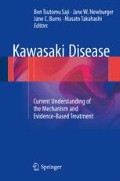Abstract
Kawasaki Disease (KD) vasculopathy, which most significantly affects the coronary arteries, is characterized by three linked pathological processes: necrotizing arteritis, subacute/chronic (SA/C) vasculitis, and luminal myofibroblastic proliferation (LMP). Necrotizing arteritis (NA), initiated at the endothelial luminal surface, leads to giant aneurysms that can rupture or thrombose. SA/C vasculitis begins in the adventitia and is closely associated with LMP. LMP consists of actively proliferating smooth muscle cell-derived myofibroblasts and their matrix products, and can result in progressive arterial luminal stenosis. All three processes begin in the first 2 weeks after fever onset. NA subsides in the first 2 weeks, while subacute/chronic vasculitis and LMP can persist for months or years. The clinical and epidemiological features of KD are best explained by infection with an as-yet-unidentified ubiquitous agent, likely a virus entering via the respiratory route. Recent advances in genomics and RNA sequencing are beginning to reveal specific immune response dysfunction in KD that could lead to new diagnostics and therapeutics for this important childhood illness.
Access this chapter
Tax calculation will be finalised at checkout
Purchases are for personal use only
References
Orenstein JM, Shulman ST, Fox LM, Baker SC, Takahashi M, Bhatti TR, et al. Three linked vasculopathic processes characterize Kawasaki disease: a light and transmission electron microscopic study. PLoS One. 2012;7(6):e38998. http://dx.doi.org/10.1371/journal.pone.0038998 PMID:22723916.
Fujiwara H, Hamashima Y. Pathology of the heart in Kawasaki disease. Pediatrics. 1978;61(1):100–7. PMID:263836.
Amano S, Hazama F, Hamashima Y. Pathology of Kawasaki disease: I. Pathology and morphogenesis of the vascular changes. Jpn Circ J. 1979;43(7):633–43. http://dx.doi.org/10.1253/jcj.43.633 PMID:41111.
Kuijpers TW, Biezeveld M, Achterhuis A, Kuipers I, Lam J, Hack CE, et al. Longstanding obliterative panarteritis in Kawasaki disease: lack of cyclosporin A effect. Pediatrics. 2003;112(4):986–92. http://dx.doi.org/10.1542/peds.112.4.986 PMID:14523200.
Burke AP, Virmani R, Perry LW, Li L, King TM, Smialek J. Fatal Kawasaki disease with coronary arteritis and no coronary aneurysms. Pediatrics. 1998;101(1 Pt 1):108–12. http://dx.doi.org/10.1542/peds.101.1.108 PMID:9417162.
Satoda M, Tatsukawa H, Katoh S. Images in cardiovascular medicine. Sudden death due to rupture of coronary aneurysm in a 26-year-old man. Circulation. 1998;97(7):705–6. http://dx.doi.org/10.1161/01.CIR.97.7.705 PMID:9495308.
Heaton P, Wilson N. Fatal Kawasaki disease caused by early occlusive coronary artery disease. Arch Dis Child. 2002;87(2):145–6. http://dx.doi.org/10.1136/adc.87.2.145 PMID:12138067.
Ozawa J, Suzuki H, Hasegawa S, Numano F, Haniu H, Watanabe K, et al. Two cases of new coronary aneurysms that developed in the late period after Kawasaki disease. Pediatr Cardiol. 2013;34(8):1992–5. http://dx.doi.org/10.1007/s00246-012-0543-x PMID:23052675.
Toyono M, Shimada S, Aoki-Okazaki M, Kubota H, Oyamada J, Tamura M, et al. Expanding coronary aneurysm in the late phase of Kawasaki disease. Pediatr Int. 2012;54(1):155–8. http://dx.doi.org/10.1111/j.1442-200X.2011.03403.x PMID:22335330.
Tsuda E, Kamiya T, Ono Y, Kimura K, Echigo S. Dilated coronary arterial lesions in the late period after Kawasaki disease. Heart. 2005;91(2):177–82. http://dx.doi.org/10.1136/hrt.2003.025338 PMID:15657227.
Kobayashi T, Sone K, Shinohara M, Kosuda T, Kobayashi T. Images in cardiovascular medicine. Giant coronary aneurysm of Kawasaki disease developing during postacute phase. Circulation. 1998;98(1):92–3. http://dx.doi.org/10.1161/01.CIR.98.1.92 PMID:9665066.
Kawai H, Takakuwa Y, Naruse H, Sarai M, Motoyama S, Ito H, et al. Two cases with past Kawasaki disease developing acute myocardial infarction in their thirties, despite being regarded as at low risk for coronary events. Heart Vessels. 2014. http://dx.doi.org/10.1007/s00380-014-0541-4 PMID:24985931.
Tsuda E, Hanatani A, Kurosaki K, Naito H, Echigo S. Two young adults who had acute coronary syndrome after regression of coronary aneurysms caused by Kawasaki disease in infancy. Pediatr Cardiol. 2006;27(3):372–5. http://dx.doi.org/10.1007/s00246-005-1233-8 PMID:16565902.
Brown TJ, Crawford SE, Cornwall ML, Garcia F, Shulman ST, Rowley AH. CD8 T lymphocytes and macrophages infiltrate coronary artery aneurysms in acute Kawasaki disease. J Infect Dis. 2001;184(7):940–3. http://dx.doi.org/10.1086/323155 PMID:11528596.
Rowley AH, Eckerley CA, Jäck HM, Shulman ST, Baker SC. IgA plasma cells in vascular tissue of patients with Kawasaki syndrome. J Immunol. 1997;159(12):5946–55. PMID:9550392.
Rowley AH, Shulman ST, Mask CA, Finn LS, Terai M, Baker SC, et al. IgA plasma cell infiltration of proximal respiratory tract, pancreas, kidney, and coronary artery in acute Kawasaki disease. J Infect Dis. 2000;182(4):1183–91. http://dx.doi.org/10.1086/315832 PMID:10979916.
Greil GF, Seeger A, Miller S, Claussen CD, Hofbeck M, Botnar RM, et al. Coronary magnetic resonance angiography and vessel wall imaging in children with Kawasaki disease. Pediatr Radiol. 2007;37(7):666–73. http://dx.doi.org/10.1007/s00247-007-0498-x PMID:17541574.
Rowley AH, Baker SC, Orenstein JM, Shulman ST. Searching for the cause of Kawasaki disease–cytoplasmic inclusion bodies provide new insight. Nat Rev Microbiol. 2008;6(5):394–401. http://dx.doi.org/10.1038/nrmicro1853 PMID:18364728.
Rowley AH, Baker SC, Shulman ST, Rand KH, Tretiakova MS, Perlman EJ, et al. Ultrastructural, immunofluorescence, and RNA evidence support the hypothesis of a “new” virus associated with Kawasaki disease. J Infect Dis. 2011;203(7):1021–30. http://dx.doi.org/10.1093/infdis/jiq136 PMID:21402552.
Onouchi Y. Genetics of Kawasaki disease: what we know and don’t know. Circ J. 2012;76(7):1581–6. http://dx.doi.org/10.1253/circj.CJ-12-0568 PMID:22789975.
Reindel R, Baker SC, Kim KY, Rowley CA, Shulman ST, Orenstein JM, et al. Integrins α4 and αM, collagen1A1, and matrix metalloproteinase 7 are upregulated in acute Kawasaki disease vasculopathy. Pediatr Res. 2013;73(3):332–6. http://dx.doi.org/10.1038/pr.2012.185 PMID:23344661.
Reindel R, Bischof J, Kim KY, Orenstein JM, Soares MB, Baker SC, et al. CD84 is markedly up-regulated in Kawasaki disease arteriopathy. Clin Exp Immunol. 2014;177(1):203–11. http://dx.doi.org/10.1111/cei.12327 PMID:24635044.
Reindel R, Kim KY, Baker SC, Shulman ST, Perlman EJ, Lingen MW, et al. Periostin is upregulated in coronary arteriopathy in Kawasaki disease and is a potential diagnostic biomarker. Pediatr Infect Dis J. 2014;33(6):659–61. http://dx.doi.org/10.1097/INF.0000000000000233 PMID:24476956.
Author information
Authors and Affiliations
Corresponding author
Editor information
Editors and Affiliations
Rights and permissions
Copyright information
© 2017 Springer Japan
About this chapter
Cite this chapter
Rowley, A.H., Shulman, S.T., Orenstein, J.M. (2017). Pathophysiology of Kawasaki Disease. In: Saji, B., Newburger, J., Burns, J., Takahashi, M. (eds) Kawasaki Disease. Springer, Tokyo. https://doi.org/10.1007/978-4-431-56039-5_6
Download citation
DOI: https://doi.org/10.1007/978-4-431-56039-5_6
Published:
Publisher Name: Springer, Tokyo
Print ISBN: 978-4-431-56037-1
Online ISBN: 978-4-431-56039-5
eBook Packages: MedicineMedicine (R0)

